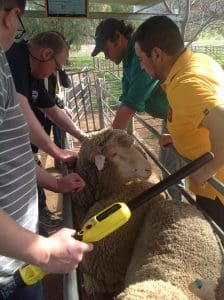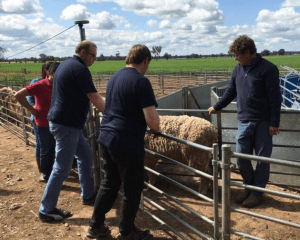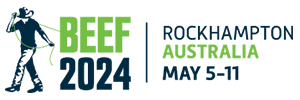
Falklands Landholdings Corporation general manager Andy Pollard, left, with managers Steven Dickson, Keith Alazia and Gilbert Castro inspect rams with Chad Taylor, (middle) at his Mumblebone stud.
FALKLAND Islands sheep producers are continuing their quest to improve lamb survival rates with the help of Australian polled Merino semen.
In the latest chapter in a campaign that started about 10 years ago, Falklands Landholdings Corporation general manager Andy Pollard, and three farm managers, recently spent three weeks inspecting Australian studs for proven and young poll sires with high fat and muscle ASBVs.
The studs visited included the Karbullah Poll Merino stud at Goondiwindi in Queensland, and the New South Wales studs of Trigger Vale at Lockhart, Centre Plus Poll at Tullamore and Mumblebone near Wellington.
The corporation has used sires over the last decade with high fleece weights and growth rates – greasy wool cut averages 3.75kg of 25 micron wool — but less attention has been paid to hardiness and fertility.
Trigger Vale co-stud principal Andrew Bouffler said the stud has been selling semen into the Falklands since about 2006, with an increased focus on sending high fat and muscle genetics since 2008, when he visited as a Nuffield scholar.
“They are really kicking goals with ewe survival and lambs – it just works, this fat and muscle.”
“If it works there it is going to work everywhere,” he said.
“The tougher and harder the environment, the more the fat and muscle is important, it is just proven now.”
Semen from Australian rams with positive Australian Sheep Breeding Values for fat and muscle, and superior wool traits, were used last year in artificial insemination programs over 4000 Merino ewes in the Falklands Landholdings Corporation’s ram breeding nucleus.
The Karbullah Poll Merino stud last year supplied more than 5000 doses of semen from three of their top sires with leading figures for yearling fat and muscle. Stud owner Mark Murphy said positive fat and muscle helped improve metabolic efficiency, enabling sheep to better handle environmental challenges. The stud now had sires with lamb survival rates equal to or better than those in labour-intensive shedded facilities in the European Union, due to selection for high fat and muscle characteristics over the last decade.
Centre Plus Poll’s Robert Mortimer manages the stud’s breeding nucleus with his son Mark, and he said ram semen had been sold to Falkland Islands farms for about four years, including to the corporation. The stud’s performance through the national genetic information and benchmarking service MerinoSelect had attracted the Falkland Islands demand, he said.
“The fact that they are happy and want more semen shows it is achieving something for them.”
Falkland lamb marking rate of 60-70pc needs improvement

Trigger Vale’s Andrew Bouffler, right, shows the Falkland Islands farmers his sires.
Superior rams from the program will eventually be used across the corporation’s ewe flock of 60,000 to boost lamb survival. Newborn lambs struggle to gain the necessary body condition and liveweight to satisfy tight meat industry specifications in one of the world’s harshest climates. Young ewes are generally not being mated until two and a half years of age.
Falklands Landholdings Corporation manages around 300,000 hectares, typically shearing 150,000 sheep and supplying 20,000 yearling lambs and mutton to the local European Union approved meat works. The island’s short summer growing season and extended cold period from late mid-autumn to late spring affects sheep liveweight and body condition.
Mr Pollard said the corporation was keen to improve sheep reproductive performance, and lamb growth and finishing, while steadily continuing to lift wool traits. Despite conception rates of more than 90pc, lamb marking rates are 60-70pc and considerable losses also occur between weaning and shearing.
Mr Pollard said improved hardiness was sought through positive genetic fat and eye muscle on a plain-bodied, mid-micron polled Merino sheep. He said objective data was being collected at weaning and shearing. However, fat and muscle was unable to be measured in the Falklands.
Mr Pollard said a second lamb drop was due in October-November following an AI program in April-May using Australian semen across 4500 Merino ewes averaging 25 micron.
“We are (in Australia) looking at animals on-farm with a view to purchasing further semen for the projects.
“We do want to improve the wool productivity traits with the five year plant to get down to 22-23 micron but are mainly concentrating on early growth rate, fat and muscle,’’ Mr Pollard said.
“It will be a substantial program that will probably see us purchasing $125,000 of Australian semen.’’
Falkland buyers visit studs using science and performance
Mr Pollard said Mumblebone Merinos had been identified as one of a small number of progressive Australian studs working on these traits. Last year, Mumblebone supplied 1500 doses of semen from double poll sire 120048.
Mumblebone principal Chad Taylor said the ram’s staple length and worm resistance, growth, clean fleece weight and overall conformation made him a stand-out sire. The first progeny of 120048 recorded the heaviest liveweights at weaning in one of the Falkland Islands flocks.
He said the Falkland Islands producers had a good understanding of how muscle and fat drove conception rates and lamb survival.
“They are now looking for new families and superior genetics to make improvements to their ram breeding program.
“They had a good balance of traits in mind with a focus on fat and muscle in conjunction with good growth rates and wool quality,’’ he said.
Mr Taylor said young sires with ASBVs in the top 5pc for muscle and fat, growth rates in the top 20pc of the industry, and above average fleece weights, caught the visiting group’s eye.
“The challenge of raising sheep in the Falkland’s under extreme winters really highlights benefits of muscle and fat as these are the traits that lift condition score.
“In Australia, those environmental challenges may come in the form of extended droughts or periods of poor nutrition, but it’s these periods of challenge that raise the benefits for breeding sheep with the in-built ability to maintain their condition,’’ he said.
“It was the science that brought the Falkland Islands producers to Australia, and the studs they are visiting are well down the path of incorporating that science in their breeding programs.’’



HAVE YOUR SAY